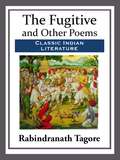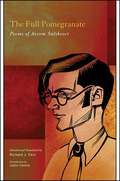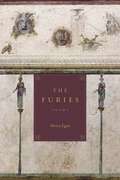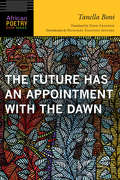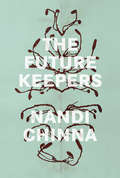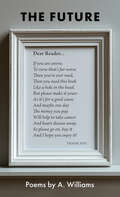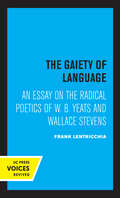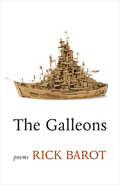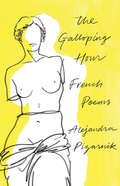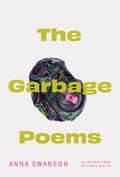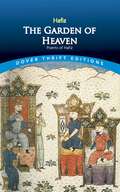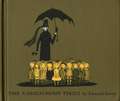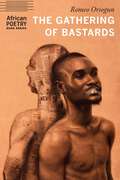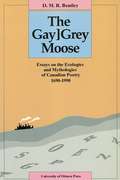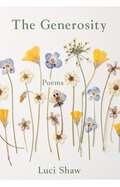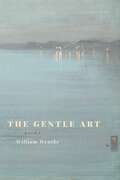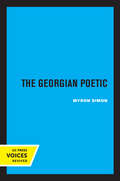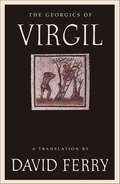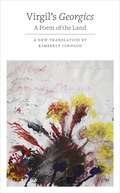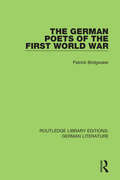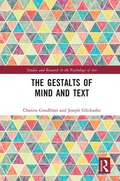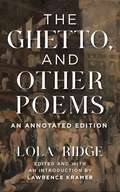- Table View
- List View
The Fugitive and Other Poems
by Rabindranath TagoreThe first non-Western writer to win the Nobel Prize in Literature Rabindranath Tagore was the literary voice of India. 'The Fugitive' is an excellent example of his work, featuring six stories and several spiritual songs.
The Full Pomegranate: Poems of Avrom Sutzkever (Excelsior Editions)
by Avrom SutzkeverYiddish writer Avrom Sutzkever (1913–2010) was described by the New York Times as "the greatest poet of the Holocaust." Born in present-day Belarus, Sutzkever spent his childhood as a war refugee in Siberia, returned to Poland to participate in the interwar flourishing of Yiddish culture, was confined to the Vilna ghetto during the Nazi occupation, escaped to join the Jewish partisans, and settled in the new state of Israel after the war. Personal and political, mystical and national, his body of work, including more than two dozen volumes of poetry, several of stories, and a memoir, demonstrated the ways in which Yiddish creativity simultaneously balanced the imperatives of mourning and revival after the Holocaust. In The Full Pomegranate, Richard J. Fein selects and translates some of Sutzkever's best poems covering the full breadth of his career. Fein's translations appear alongside the original Yiddish, while an introduction by Justin Cammy situates Sutzkever in both historical and literary context.
The Furies: Poems
by Moira EganIn The Furies, Moira Egan offers fierce feminist reimaginings of familiar myths and narratives, from Arachne to Echo, from Medusa and Mary Magdalene to the female characters of The Odyssey, in verse that highlights the value of solidarity and collective strength among women. With dazzling erudition and playful ingenuity, she deploys exuberant wordplay and traditional poetic forms to subvert the patriarchal canon. At the heart of the book is a profound exploration of voice, not least the ongoing silencing of women’s voices: Egan blends righteous anger with grief, ultimately finding hope in the transformative power of language.
The Future Has an Appointment with the Dawn (African Poetry Book)
by Honorée Fanonne Jeffers Todd Fredson Tanella BoniTanella Boni is a major African poet, and this book, The Future Has an Appointment with the Dawn, is her first full collection to be translated into English. These poems wrestle with the ethnic violence and civil war that dominated life in West Africa’s Ivory Coast in the first decade of the new millennium. Boni maps these events onto a mythic topography where people live among their ancestors and are subject to the whims of the powerful, who are at once magical and all too petty. The elements—the sun, the wind, the water—are animated as independent forces, beyond simile or metaphor. Words, too, are elemental, and the poet is present in the landscape—“during these times / I searched for the letters / for the perfect word.” Boni affirms her desire for hope in the face of ethno‑cultural and state violence although she acknowledges that desiring to hope and hoping are not the same.
The Future Keepers
by Nandi ChinnaThe poems in The Future Keepers honour ecosystems and thecustodians of future ecologies. They navigate the poet's ownembodied experiences of change and succession – of family,community and place. From the research scientists, gardeners, birdsand plants of Kings Park, to the activism and ecosystems of the BeeliarWetlands, to the poet's own inherited landscapes, these poems evokemutuality and exchange in speaking of the gifts we receive from beingopen to encounters with other species, and the reciprocity that thesegifts imply.
The Future: Facts And Perspectives Inpharzam Medical Forum, Lugano, April 1986: Proceedings Modern Trend In The Treatment Of Lower Urinary Tract Infections: Monuril As Oral Single-dose Therapy Satellite Symposium To The 77th International Symposium On Future Trends In Chemotherapy, Tirrenia, May 1986: Proceedings. Supplement Issue: European Urology 1987, Vol. 13, Suppl. 1
by A. WilliamsIn this captivating collection, a seasoned poet with over nine decades of life experience invites readers on a lyrical journey through the passions that have coloured his world. With a voice honed by years of observation and introspection, he paints vivid word-pictures that bring to life the thundering hooves on the racetrack, the graceful arc of a diver’s plunge, and the roar of engines on the speedway. But this is more than just a sports anthology. Drawing from a well of diverse interests, the poet serves up verses seasoned with culinary adventures, musical interludes, and the thrill of intellectual pursuits. Each poem is a window into a life richly lived, offering readers a unique perspective on the human experience. Whether you’re a sports enthusiast, a lover of life’s finer pleasures, or simply someone who appreciates the wisdom that comes with age, this collection promises to entertain, inspire, and provoke thought. Join this passionate wordsmith as he shares the accumulated insights of a lifetime, proving that the fire of creativity burns bright at any age.
The Gaiety of Language: An Essay on the Radical Poetics of W. B. Yeats and Wallace Stevens (Perspectives in Criticism #19)
by Frank LentricchiaThis title is part of UC Press's Voices Revived program, which commemorates University of California Press’s mission to seek out and cultivate the brightest minds and give them voice, reach, and impact. Drawing on a backlist dating to 1893, Voices Revived makes high-quality, peer-reviewed scholarship accessible once again using print-on-demand technology. This title was originally published in 1968.
The Galleons: Poems
by Rick BarotLonglisted for the National Book Award for PoetryFinalist for the Pacific Northwest Book AwardA New York Public Library Best Book of 2020For almost twenty years, Rick Barot has been writing some of the most stunningly crafted lyric poems in America, paying careful, Rilkean attention to the layered world that surrounds us. In The Galleons, he widens his scope, contextualizing the immigrant journey of his Filipino-American family in the larger history and aftermath of colonialism.These poems are engaged in the work of recovery, making visible what is often intentionally erased: the movement of domestic workers on a weekday morning in Brooklyn; a veteran of the war in Afghanistan, fondly sharing photos of his dog; the departure and destination points of dozens of galleons between 1564 and 1815, these ships evoking both the vast movements of history and the individual journeys of those borne along by their tides. “Her story is a part of something larger, it is a part / of history,” Barot writes of his grandmother. “No, her story is an illumination // of history, a matchstick lit in the black seam of time.”With nods toward Barot’s poetic predecessors—from Frank O’Hara to John Donne—The Galleons represents an exciting extension and expansion of this virtuosic poet’s work, marrying “reckless” ambition and crafted “composure,” in which we repeatedly find the speaker standing and breathing before the world, “incredible and true.”
The Galloping Hour: French Poems
by Forrest Gander Alejandra Pizarnik Patricio FerrariA beautifully produced and exquisitely translated edition of French poems by “the best exponent of the poetry of introversion and metaphorical delirium” (Italo Calvino) The Galloping Hour: French Poems—never before rendered in English and unpublished during her lifetime—gathers for the first time all the poems that Alejandra Pizarnik (revered by Octavio Paz and Roberto Bolan~o) wrote in French. Conceived during her Paris sojourn (1960–1964) and in Buenos Aires (1970–1971) near the end of her tragically short life, these poems explore many of Pizarnik’s deepest obsessions: the limitation of language, silence, the body, night, sex, and the nature of intimacy. Drawing from personal life experiences and echoing readings of some of her beloved/accursed French authors—Charles Baudelaire, Germain Nouveau, Arthur Rimbaud, and Antonin Artaud—this collection includes prose poems that Pizarnik would later translate into Spanish. Pizarnik’s work led Rau´l Zurita to note: “Her poetry—with a clarity that becomes piercing—illuminates the abysses of emotional sensitivity, desire, and absence. It presses against our lives and touches the most exposed, fragile, and numb parts of humanity.”
The Garbage Poems
by Anna SwansonPoems that repurpose the language of beer cans and fast-food wrappers to explore everything from chronic illness to climate crisis to the joy of wild swimming.Created entirely out of words found on trash collected at local swimming holes, Anna Swanson’s garbage poems reclaim hyperbolic corporate marketing-speak for the expression of physical pleasure, queerness, and vulnerability. Written in the years following a head injury, this book traces the connections experienced in the fiercely embodied act of swimming with a chronically ill body. Paired with tender watercolour illustrations of the source garbage by award-winning artist April White, these poems refuse to conform to an illness-and-cure narrative and instead become a vibrant archive of the process of piecing together a voice back together from fragments, an urgent study of the deeply political nature of joy.
The Garden of Heaven: Poems of Hafiz (Dover Thrift Editions)
by HafizPoetry is the greatest literary form of ancient Persia and modern Iran, and the fourteenth-century poet known as Hafiz is its preeminent master. Little is known about the poet's life, and there are more legends than facts relating to the particulars of his existence. This mythic quality is entirely appropriate for the man known as "The Interpreter of Mysteries" and "The Tongue of the Hidden," whose verse is regarded as oracular by those seeking guidance and attempting to realize wishes.A mere fraction of what is presumed to have been an extensive body of work survives. This collection is derived from Hafiz's Divan (collected poems), a classic of Sufism. The short poems, called ghazals, are sonnet-like arrangements of varied numbers of couplets. In the tradition of Persian poetry and Sufi philosophy, each poem corresponds to two interpretations, sensual and mystic.This outstanding translation of Hafiz's poetry was created by historian and Arabic scholar Gertrude Bell, who observed, "These are the utterances of a great poet, the imaginative interpreter of the heart of man; they are not of one age, or of another, but for all time."
The Gardens of Emily Dickinson
by Judith Farr Louise CarterIn this first substantial study of Emily Dickinson's devotion to flowers and gardening, Judith Farr seeks to join both poet and gardener in one creative personality. She casts new light on Dickinson's temperament, her aesthetic sensibility, and her vision of the relationship between art and nature, revealing that the successful gardener's intimate understanding of horticulture helped shape the poet's choice of metaphors for every experience: love and hate, wickedness and virtue, death and immortality. Gardening, Farr demonstrates, was Dickinson's other vocation, more public than the making of poems but analogous and closely related to it. Over a third of Dickinson's poems and nearly half of her letters allude with passionate intensity to her favorite wildflowers, to traditional blooms like the daisy or gentian, and to the exotic gardenias and jasmines of her conservatory. Each flower was assigned specific connotations by the nineteenth century floral dictionaries she knew; thus, Dickinson's association of various flowers with friends, family, and lovers, like the tropes and scenarios presented in her poems, establishes her participation in the literary and painterly culture of her day. A chapter, "Gardening with Emily Dickinson" by Louise Carter, cites family letters and memoirs to conjecture the kinds of flowers contained in the poet's indoor and outdoor gardens. Carter hypothesizes Dickinson's methods of gardening, explaining how one might grow her flowers today. Beautifully illustrated and written with verve, The Gardens of Emily Dickinson will provide pleasure and insight to a wide audience of scholars, admirers of Dickinson's poetry, and garden lovers everywhere.
The Gashlycrumb Tinies
by Edward GoreyOnly for those with a macabre sense of humor, a short poem of 26 lines, one for each letter of the alphabet.
The Gathering of Bastards (African Poetry Book)
by Romeo OriogunLike I knew, standing on the seashore, the hunger wracking a migrant&’s body is movement. —from Romeo Oriogun&’s &“Migrant by the Sea&”The Gathering of Bastards chronicles the movement of migrants as they navigate borders both internal and external. At the heart of these poems of vulnerability and sharp intelligence, the poet himself is the perpetual migrant embarked on forced journeys that take him across nations in West and North Africa, through Europe, and through American cities as he navigates the challenges of living through terror and loss and wrestles with the meaning of home.
The Gay-Grey Moose: Essays on the Ecologies and Mythologies of Canadian Poetry, 1690-1990
by D. M. R. BentleyThe Gay-Grey Moose is a collection of essays presenting a comprehensive view of English poetry in Canada from the early colonial period to the Post-Modern era. From a wide range of poets, this book provides fresh contexts for viewing and discussing three centuries of English Canadian poetry. Both national and regional in its orientation, it seeks to discover the relationship between poetry and landscape in a poetic continuity that stretches from the late 17th century to the present.
The Generosity (Paraclete Poetry)
by Luci Shaw"Rejoice, readers, as you receive the generosity of Luci Shaw's 76 new grace-infused parable poems. Autobiography once more merges with theology as these poems illuminate in splendored natural detail how the seasons of creation parallel and explain the seasons of her life as a poet. Again and again, these poems shower us with glorious epiphanies from the natural world as it reflects God's generosity at work such as "spring's impossible news of green." These poems confirm that in poetry as in faith "ripeness is all." Like Wordsworth, Luci is celebrated for being a highly gifted landscape poet whose works are rich in imagery from the physical world—meadows filled with seeds, flowers, and also poems which are like "shoots" in Luci's writing life. Animals, too, great and small (beetles, cricket, and voles to bears and whales) play a major role in Luci's poetics of creation; God is likened to a great bear who leaves paw tracks for us to follow. In their deep faith and vibrant colors and designs, the poems in Generosity might be considered Luci's Book of Kells. We need to be like Luci's father who carried her poems in his briefcase to show his friends." —Philip C. Kolin, Author, Reaching Forever: Poems; Distinguished Professor of English (Emeritus), University of Southern Mississippi
The Gentle Art: Poems
by William WentheThe poems in The Gentle Art, a compelling new collection from William Wenthe, move between the life of the painter James McNeill Whistler and a poetic version of the author, who is at once inspired and disturbed by Whistler. The present-day author sheds light on Whistler’s artistic vocation and the beauty of his paintings, most notably the liminal London riverscapes that he named Nocturnes, yet recoils at the cost of Whistler’s devotion to art: lovers abandoned, friends turned into enemies, his own children given away to adoption.Creating a kind of dual biography, Wenthe grapples with feelings of admiration and disaffection toward Whistler as he tries to perform his own roles as parent, partner, and poet. While some of the poems are narrative, their overall effect is associative—two lives superimposed in a double exposure, with attention to what the contrast of two centuries, the nineteenth and the twenty-first, reveals about the relationship of art to money, class, and politics.
The Georgian Poetic
by Myron SimonThis title is part of UC Press's Voices Revived program, which commemorates University of California Press’s mission to seek out and cultivate the brightest minds and give them voice, reach, and impact. Drawing on a backlist dating to 1893, Voices Revived makes high-quality, peer-reviewed scholarship accessible once again using print-on-demand technology. This title was originally published in 1975.
The Georgics of Virgil: A Translation
by David FerryJohn Dryden called Virgil's Georgics, written between 37 and 30 B.C.E., "the best poem by the best poet." The poem, newly translated by the poet and translator David Ferry, is one of the great songs, maybe the greatest we have, of human accomplishment in difficult--and beautiful--circumstances, and in the context of all we share in nature.The Georgics celebrates the crops, trees, and animals, and, above all, the human beings who care for them. It takes the form of teaching about this care: the tilling of fields, the tending of vines, the raising of the cattle and the bees. There's joy in the detail of Virgil's descriptions of work well done, and ecstatic joy in his praise of the very life of things, and passionate commiseration too, because of the vulnerability of men and all other creatures, with all they have to contend with: storms, and plagues, and wars, and all mischance.As Rosanna Warren noted about Ferry's work in The Threepenny Review, "We finally have an English Horace whose rhythmical subtlety and variety do justice to the Latin poet's own inventiveness, in which emotion rises from the motion of the verse . . . To sense the achievement, one has to read the collection as a whole . . . and they can take one's breath away even as they continue breathing."This ebook edition includes only the English language translation of the Georgics.
The Georgics: The Georgics
by VirgilOne of the greatest poems of the classical world, Virgil's Georgics is a glorious celebration of the eternal beauty of the natural world, now brought vividly to life in a powerful new translation.'Georgic' means 'to work the earth', and this poetic guide to country living combines practical wisdom on tending the land with exuberant fantasy and eulogies to the rhythms of nature. It describes hills strewn with wild berries in 'vine-spread autumn'; recommends watching the stars to determine the right time to plant seeds; and gives guidance on making wine and keeping bees. Yet the Georgics also tells of angry gods, bloody battles and a natural world fraught with danger from storms, pests and plagues. Expansive in its scope, lush in its language, this extraordinary work is at once a reflection on the cycles of life, death and rebirth, an argument for the nobility of labour and an impassioned reflection on the Roman Empire of Virgil's times. Kimberly Johnson's lyrical verse translation captures all the rich beauty and abundant imagery of the original, re-creating this ancient masterpiece for our times.
The German Poets of the First World War
by Patrick BridgwaterOriginally published in 1985, this book provides a full survey of the best and most significant work of German writers to the First World War. Including (in both German and English) the texts of all the main poems discussed, this book contains many not readily available elsewhere. Authors discussed include Trakl, Rile and George as well as less familiar names . The book not only corrects the distorted view of the subject perpetuated by most histories of German literature, but will also help to English First World War poetry into perspective.
The Gestalts of Mind and Text (Studies and Research in the Psychology of Art)
by Chanita Goodblatt Joseph GlicksohnThe Gestalts of Mind and Text bridges literary studies and cognitive psychology to provide a unique contribution to the field of Cognitive Literary Studies. The book presents an investigation of metaphor in poetic texts, adopting and developing empirical methods used by Gestalt Psychology, while integrating concepts informed by Gestalt Psychology. The title indicates an intellectual tradition, to be termed the Gestalt of the Mind, that begins with the Würzburg School of Psychology and its subsequent development into Gestalt Psychology, which provides a rich heritage for the field of Cognitive Literary Studies. The title further indicates an intellectual and creative tradition, to be termed the Gestalt of the Text, applied to various literary schools (Medieval, Early Modern, Modernist). Finally, the Gestalt-Interaction Theory of Metaphor delineates the potentialities for different types of readings of poetic metaphor. This book further makes three significant contributions: the first is the focus on the empirical investigation of metaphor in poetic texts; the second is the integration of the aspects of problem-solving, bidirectionality of metaphor, embodied cognition and the grotesque, in analyzing poetic texts and verbal protocols; and the third is the focus on various literary traditions, spanning languages and periods. The goal of this book is to present an interdisciplinary study of the Gestalts of Mind and Text. This will be of interest to a varied audience, including cognitive psychologists, literary scholars, researchers in aesthetics, scholars of metaphor and those with an interest in intellectual history.
The Ghetto, and Other Poems: An Annotated Edition
by Lola RidgeAt last recovered in this enriching annotated edition, this important but neglected work of American modernism offers a unique poetic encounter with the Jewish communities in New York’s Lower East Side.Long forgotten on account of her gender and left-wing politics, Lola Ridge is finally being rediscovered and read alongside such celebrated contemporaries as Hart Crane, William Carlos Williams, and Marianne Moore—all of whom knew her and admired her work. In her time Ridge was considered one of America’s leading poets, but after her death in 1941 she and her work effectively disappeared for the next seventy-five years. Her book The Ghetto and Other Poems, is a key work of American modernism, yet it has long, and unjustly, been neglected. When it was first published in 1918—in an abbreviated version in The New Republic, then in full by B. W. Huebsch five months later—The Ghetto and Other Poems was a literary sensation. The poet Alfred Kreymbourg, in a Poetry Magazine review, praised “The Ghetto” for its “sheer passion, deadly accuracy of versatile images, beauty, richness, and incisiveness of epithet, unfolding of adventures, portraiture of emotion and thought, pageantry of pushcarts—the whole lifting, falling, stumbling, mounting to a broad, symphonic rhythm.” Louis Untermeyer, writing in The New York Evening Post, found “The Ghetto” “at once personal in its piercing sympathy and epical in its sweep. It is studded with images that are surprising and yet never strained or irrelevant; it glows with a color that is barbaric, exotic, and as local as Grand Street.”The long title poem is a detailed and sympathetic account of life in the Jewish Ghetto of New York’s Lower East Side, with particular emphasis on the struggles and resilience of women. The subsequent section, “Manhattan Lights,” delves further into city life and immigrant experience, illuminating life in the Bowery. Other poems stem from Ridge’s lifelong support of the American labor movement, and from her own experience as an immigrant. This critical edition seeks to recover the attention The Ghetto, and Other Poems, and in particular the title poem, lost after Ridge’s death. The poems in the volume are as aesthetically strong as they are historically revealing. Their language combines strength and directness with startling metaphors, and their form embraces both panoramic sweep and lyrical intensity. Expertly edited and annotated by Lawrence Kramer, this first modern edition to reproduce the full 1918 publication of The Ghetto and Other Stories offers all the background and context needed for a rich, informed reading of Lola Ridge’s masterpiece.
